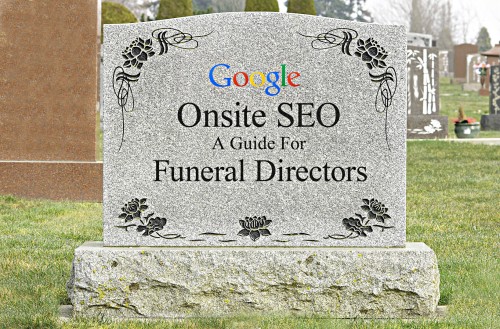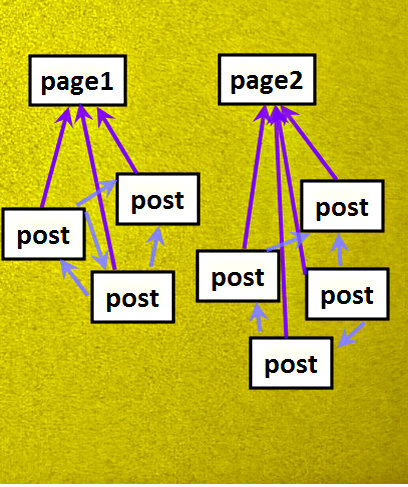Posted by Mark Sharron
For the third part in this series on SEO for funeral directors I’m going to explore onsite SEO. The goal of this post is to give you an understanding of how the major search engines view your website’s funerary focused content.
If you think back in time before Google existed, the internet was a disorganized unsavory place. Many of you will probably retort the internet is still an unsavory disorganized place.
Before Google, if you wanted to find a website you either had to know its address or you used search engine directories e.g. Yahoo, Altavista, Lycos Dogpile and many more that have since faded into oblivion.
Search engine directories depended on webmasters to submit an honest description of their websites and place them in an appropriate category. This system was open to abuse and it made it difficult to find anything of value.
Google arrived in the mid 1990’s and quickly became the dominant choice as it was a lot better than its competitors at returning relevant results. The way Google achieved this feat is as follows:
Google used a crawler/spider to index the actual content of a website.
Google’s algorithm would then parse the text on the page and judge the relevance of a site vs the relevance of similar sites based on its actual content and assign a search engine rank position.
Duplicate content was identified and demoted within the search index.
Google then reviewed how many links were directed at a site using an algorithm called Pagerank and determined sites with a greater number of links were more reputable and again reward them with a preferential rank.
I will explore links/Pagerank in a later post. For now my intention is to focus on the mechanics of creating a strong ranking signal using the text/content on your website alone.
Onsite SEO Basics:
The most important part of any SEO campaign is keyword research. Once you have identified which keywords you want to rank for, Onsite SEO becomes nothing more than a labelling exercise.
As a funeral director the trick is to identify terms that potential customers will search for. Running an Adwords campaign can be a great help to this end.
The obvious “funeral director + location” will be your core keyword however there will be a range of terms such as “cheap funeral director” or “no-fuss funerals” that will be equally desirable.
If you want to rank for “Funeral Directors in Brighton” or a similar keyword your site needs to contain references to “Funeral Directors in Brighton” and lots of them though out the website.
Keyword Stuffing:
Please do not take this last sentence as a direction from myself to drop “Funeral Directors in Brighton” into every other line of your website. This technique is known as keyword stuffing and WILL NOT WORK.
The first problem you will encounter is the text on your site will become awkward and unreadable by potential clients. This will turn off prospective customers away from your brand.
The second and equally undesirable effect; Google will quickly identify the content on your site is low quality, an algorithm called PANDA will then penalise your site causing it to drop in rank.
Latent Semantic Indexing:
To avoid incurring a penalty, SEO’s like myself use a technique called latent Semantic Indexing. Google makes use of natural language processing and understands associations between words/language/entities. When writing content for your site the trick is to use variants of keywords, inflections, synonyms and related terms and seed your text with them.
Start with Variants:
* Funeral Director Brighton
* Brighton Funeral Director
* Undertaker
* Funeral Parlour
* Funeral Home
* Celebrant
Identify associated words:
* Death
* Cremation
* Burial
* Funeral Service
* Coffin
* Urn
* Bereavement
* Grief
* Tribute
The advantage of using this approach is your website’s content will read naturally, you will avoid a potential penalty and be rewarded with preferential placement within Google’s search index.
Writing Tip:
When I start creating content I compile a thorough list of keyword and associated terms. I then set the list aside and write the content without giving the list of keywords a second thought. After I have written the content I read through and slip keywords into sentences where possible and effecting minor re-writes if necessary. This approach saves time and the content reads naturally.
Page Structure:
Structuring the HTML on your page helps your website get noticed.
Heading Tags: Money keywords and variants are placed within unique HTML heading tags through each page.
Keyword Density: Money keyword/variants should be placed in the first paragraph and every 100-150 words.
Title Tag/Meta Description: The money keyword for any page should be the first word of the meta title and should be placed at least once in the meta description. Please note, title tags and meta descriptions should be unique for each page on your site.
Image Alt Tags: You have the option to place a text description. Again use this opportunity to work in your keywords.
Site Structure:
When building a website, I let the search engines and keyword research determine the structure. I mentioned earlier that SEO is a labelling exercise; I match each keyword to a client’s services where possible and create one page dedicated per keyword. e.g.
www.yourfuneralcompany.com/cheap-funerals/.
This approach ensures that the website will acquire a ranking signal for a broad range of keywords and creates a foundation that can be built upon.
Internal Linking:
Linking between pages on your site will again re-enforce the relevance of each page as Google recognises relationships between similar pages with similar content.
Once I have built a series of landing pages targeting specific keywords, I build a set of supporting pages and link between them and back to the page I am trying to optimise. Not only will this improve your search engine rank for the target keyword you will also start ranking for a variety of long tail variants of keywords you were not originally focusing on. The trick is to complete this process in a non-uniform manner using a variety of keywords/keyword variants and conversational anchor text as the basis of each link.
This process is known as Silo’ing. If you would like to read more about it I would recommend this article: http://www.bruceclay.com/eu/seo/silo.htm
Content Arms Race:
The more content your site has, the greater the number of keywords it will potentially rank for. Think about creative ways to add content to your site, eg, FAQ, glossary of terms, blogs, testimonials.
Exact Match Domains:
Using a domain that matches your primary keyword (exact match domain) e.g. www.brightonfuneraldirectors.co.uk doesn’t guarantee ranking but it certainly makes it easier coupled with lots of original content. Not having an exact match domain means significantly more effort needs to be placed on high quality content and relevant links.
Google Webmaster Quality Compliance:
Google will periodically conduct a manual review on your site. They have a set of quality guidelines websites should adhere to. These include:
* about page
* contact page
* terms and conditions
*private policy
* address and telephone number
* social profiles
Summary:
* Exact match domains make life easier.
* Use original keyword rich content.
* Do not keyword stuff, use variants of keywords.
* Dedicate specific pages to each keyword.
* Build supporting pages and heavily interlink content on your site.
I will cover online branding in my next post including social profile integration, schema and the Google Knowledge Graph.
As always if you have any questions, please leave a comment below and I’ll aim to answer within 24 hours.




Any other questions before I start working on the next post?
Wonderful post from you Mark many thanks for you 🙂